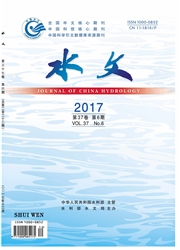

 中文摘要:
中文摘要:
基于TIGGE数据的五个单中心集合预报结果(CMA、CMC、ECMWF、NCEP、UKMO)构成的多中心超级集合预报系统的降水量预报,以及相应时段的实测降水量值,应用贝叶斯模式平均法(Bayesian Model Averaging,BMA)建立大渡河流域的BMA概率预报模型。通过CRPS、MAE、BS三种评价指标,对大渡河流域的BMA降水概率预报模型进行评价与检验,三种指标均显示BMA降水概率预报比原始集合预报具有更高的准确性,其中BMA模型的CRPS和MAE指标均值分别相比原始集合预报减少了31.6%和23.9%;分析模型权重参数,得出ECMWF对大渡河流域BMA降水预报贡献最大,即ECMWF对研究区域降水预报效果最好;模型对大渡河流域极端降水预报效果较差,常低估极端降水量。
 英文摘要:
英文摘要:
Bayesian Model Averaging (BMA) probability forecast models for the Daduhe River Basin was established by calibrating model parameters with precipitation ensemble forecasts and gauge observations. The ensemble forecasts used in this study consists of five single-center predictions from the following five agencies: the China Meteorological Administration (CMA), the Canadian Meteorological Center (CMC), the European Centre for Medium-Range Weather Forecasts (ECMWF), the United States National Center for Environmental Prediction (NCEP) and the United Kingdom Meteorological Office (UKMO) in the THORPEX Interactive Grand Global Ensemble (TIGGE). Evaluation based on continuous ranked probability score (CRPS), mean absolute error (MAE) and Brier Score (BS) shows that the BMA models are better than the original probability forecast models. The averages of CRPS and MAE of the BMA models decrease by 31.6% and 23.9%, respectively. By analyzing BMA model weights of each single-center prediction, we find that ECMWF contributes most for the models, which means ECMWF does best in precipitation forecasts in the Daduhe basin. The BMA models for the Daduhe basin does not perform well for the prediction of extreme precipitation and usually underestimate the precipitation amount.
 同期刊论文项目
同期刊论文项目
 同项目期刊论文
同项目期刊论文
 期刊信息
期刊信息
